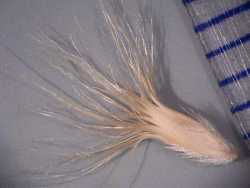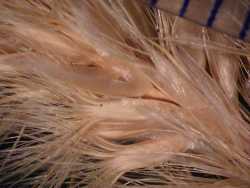Culms (40)50-100 cm. Sheaths mostly glabrous, with a tuft of hairs at the throat; blades 10-25 cm long, 2-5 mm wide, flat to involute, adaxial surfaces scabridulous. Panicles 10-25 cm, tightly contracted, usually white or tawny, rarely slightly purple-tinged. Spikelets with 1(2) bisexual florets and 2 reduced florets. Glumes (3)4-4.5 mm, glabrous, acute; lowest lemma bodies 3-3.2 mm, midveins and margins pubescent from the base to about midlength, awns about twice as long as the lemma bodies, tending to spread at right angles when mature; paleas longer than the lemma bodies. 2n = 60.
Pappophorum vaginatum grows in similar habitats to P. bicolor, the two species sometimes growing together. Its range extends from southern Arizona to Texas and northern Mexico and from Uruguay to Argentina.
Perennials, Terrestrial, not aquatic, Stems nodes swollen or brittle, Stems erect or ascending, Stems geniculate, decumbent, or lax, sometimes rooting at nodes, Stems caespitose, tufted, or clustered, Stems terete, round in cross section, or polygonal, Stems branching above base or distally at nodes, Stem internodes solid or spongy, Stems with inflorescence less than 1 m tall, Stems, culms, or scapes exceeding basal leaves, Leaves mostly cauline, Leaves conspicuously 2-ranked, distichous, Leaves sheathing at base, Leaf sheath mostly open, or loose, Leaf sheath smooth, glabrous, Leaf sheath hairy at summit, throat, or collar, Leaf sheath and blade differentiated, Leaf blades linear, Leaf blades 2-10 mm wide, Leaf blades mostly flat, Leaf blade margins folded, involute, or conduplicate, Leaf blades mostly glabrous, Ligule present, Ligule a fringe of hairs, Inflorescence terminal, Inflorescence a contracted panicle, narrowly paniculate, branches appressed or ascending, Inflorescence a dense slender spike-like panicle or raceme, branches contracted, Inflorescence solitary, with 1 spike, fascicle, glomerule, head, or cluster per stem or culm, Inflorescence single raceme, fascicle or spike, Flowers bisexual, Spikelets pedice llate, Spikelets laterally compressed, Spikelet less than 3 mm wide, Spikelets with 2 florets, Spikelets with 3-7 florets, Spikelets solitary at rachis nodes, Spikelets all alike and fertille, Spikelets bisexual, Spikelets disarticulating above the glumes, glumes persistent, Rachilla or pedicel glabrous, Glumes present, empty bracts, Glumes 2 clearly present, Glumes equal or subequal, Glumes equal to or longer than adjacent lemma, Glumes keeled or winged, Glumes 1 nerved, Lemmas thin, chartaceous, hyaline, cartilaginous, or membranous, Lemma similar in texture to glumes, Lemma 5-7 nerved, Lemma 8-15 nerved, Lemma body or surface hairy, Lemma apex dentate, 3-5 fid, Lemma distinctly awned, more than 2-3 mm, Lemma with 7-15 awns, Lemma awn less than 1 cm long, Lemma awned from tip, Lemma awns straight or curved to base, Lemma awn once geniculate, bent once, Lemma margins thin, lying flat, Lemma straight, Callus or base of lemma evidently hairy, Callus hairs shorter than lemma, Palea present, well developed, Palea membranous, hyaline, Palea about equal to lemma, Palea longer than lemma, Palea 2 nerved or 2 keeled, Palea keels winged, scabrous, or ciliate, Stamens 3, Styles 2-fid, deeply 2-branched, Stigmas 2, Fruit - caryopsis.
Common Name: whiplash pappusgrass
Duration: Perennial
Nativity: Native
Lifeform: Graminoid
General: Erect tufted perennial grass with uniformly leafy stems, 50-100 cm tall.
Vegetative: Blades 10-25 cm long, 2-5 mm wide, flat to involute, with upper surfaces minutely roughened; sheaths mostly glabrous with tuft of hairs at the the throat.
Inflorescence: Panicles 10-25 cm, tightly contracted, usually white or tawny, rarely purple tinged, interrupted between some of the lower branches, upper leaf sheath frequently enclosing base of panicle; spikelets with one or two fertile florets below and two or three sterile reduced florets above; glumes 4 mm, glabrous, acute, membranous; lowest lemmas bodies 3 mm, with pubescent margins and 5-9 pubescent veins, the veins extending into scabridulous awns twice as long as the lemma bodies, the awns forming a pappuslike crown and tending to spread at right angles when mature.
Ecology: Found in dry washes, along roadsides and in flats from 2,000-4,000 ft (610-1219 m); flowers July-September.
Distribution: s AZ to TX and n MEX; also from Uruguay to Argentina.
Notes: An upright perennial bunchgrass with distinctive with its whitish to tawny spikelike panicle, the spikelets crowned by multiple scabrous awns. Enneapogon species have a similar crown of awns, but those awns are plumose (feathery). E. desvauxii also differs in being smaller (< 50 cm) with hairy culms, blades, and panicles, and E. cenchroides has a spreading growth form.
Ethnobotany: Unknown
Etymology: Pappophorum is from Greek pappos, for fluff or beard, and phoros for carrying, while vaginatum means sheathed, referring to the leaf sheath covering the lower part of the panicle.
Synonyms: Pappophorum apertum, Pappophorum mucronulatum, Pappophorum suffulbosum
Editor: SBuckley 2010, AHazelton 2015








